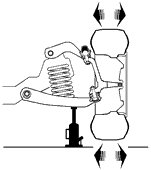Place a jack under the lower arm, near the ball joint end, and raise the tire off the floor. Check the lower joint for axial play by moving the tire/wheel assembly as indicated in Figure 1. A prypar can also be used between the lower control arm and the spindle.
Check for radial play in both lower and upper ball joints by moving the tire/wheel assembly as indicated in Figure 2.

|

|
| Figure 1 | Figure 2 |